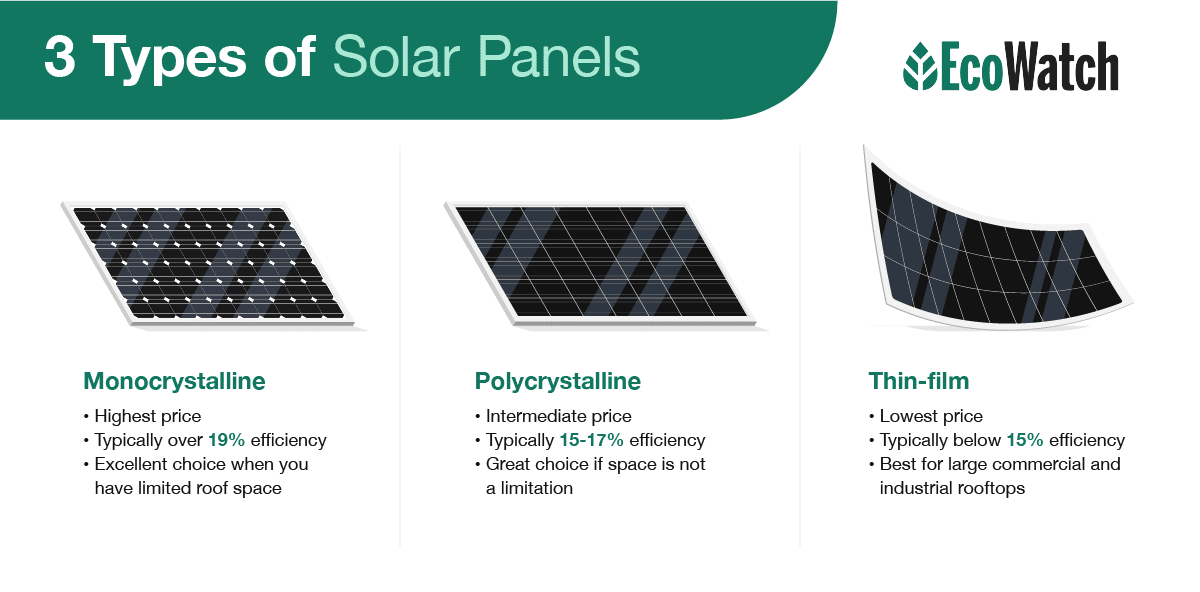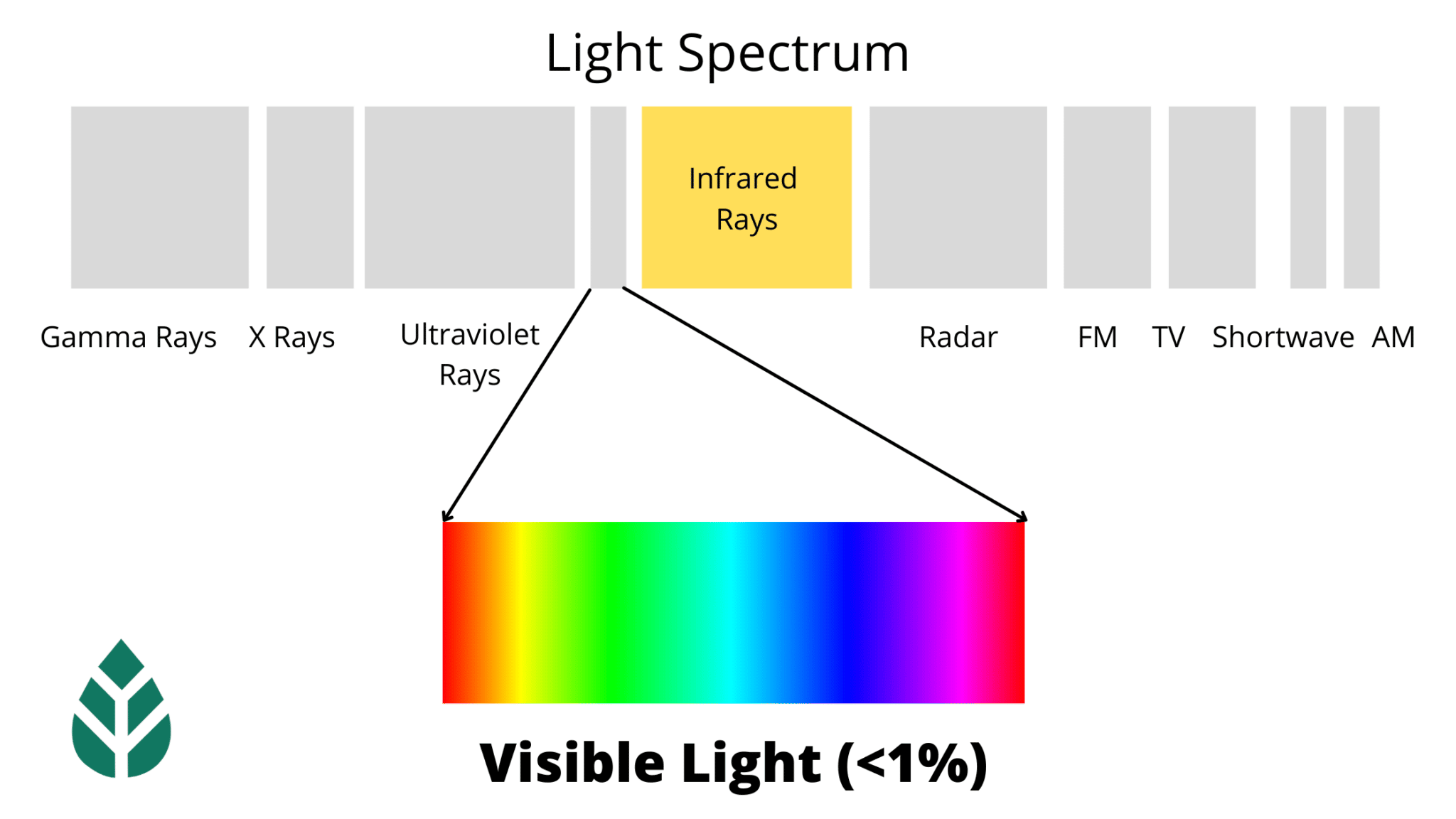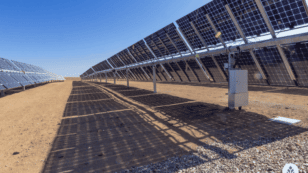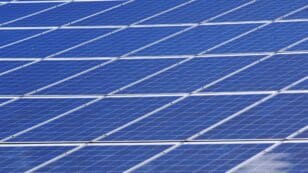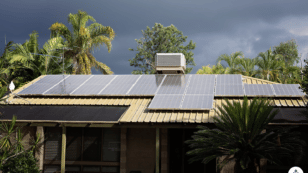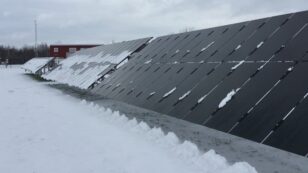
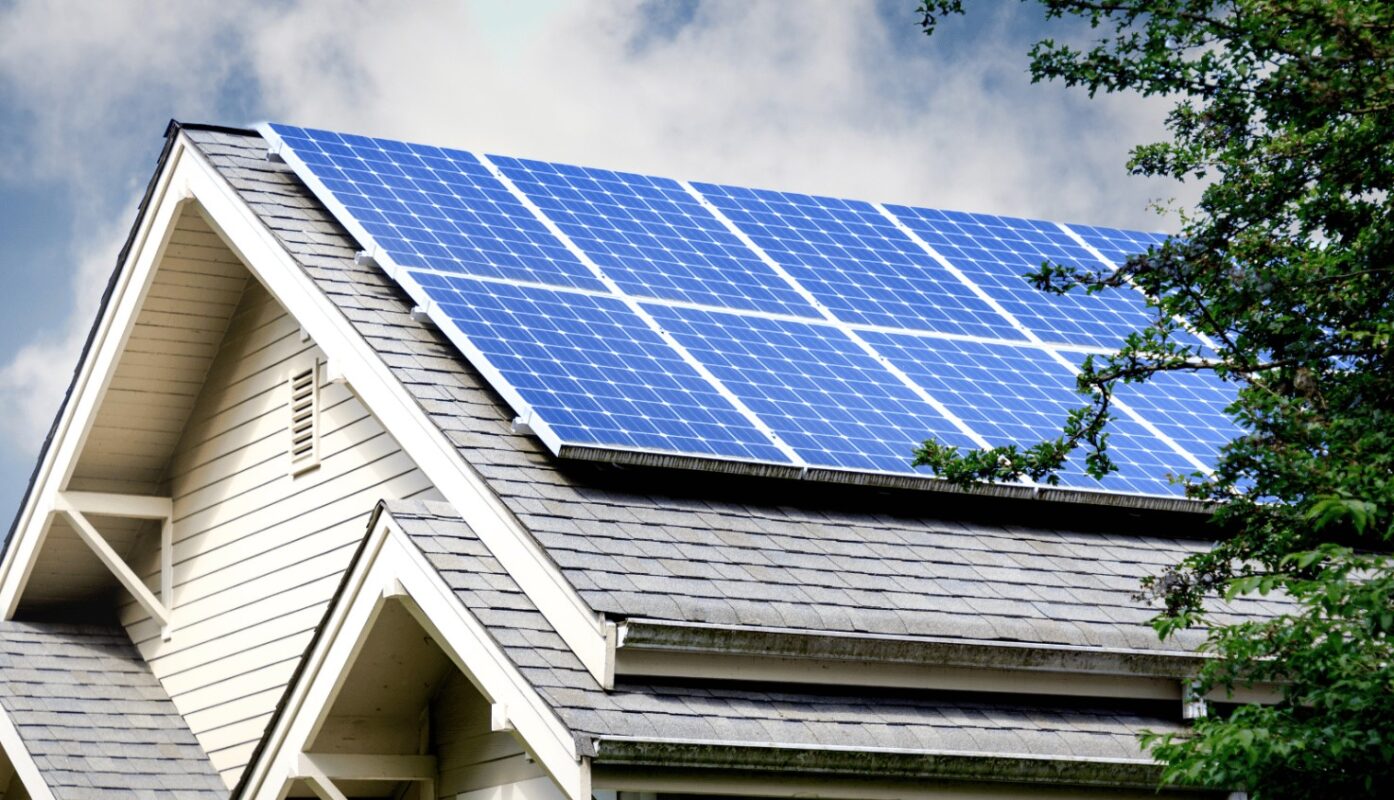
3 Types of Solar Panels (Which Is Right for You?)
Here’s what we’ll cover in this guide:
- The 3 main types of solar panels
- How to decide which type is right for you
- How panel efficiency differs
Each product and or company featured here has been independently selected by the writer. You can learn more about our review methodology here. If you make a purchase using the links included, we may earn commission.
3 Main Types of Solar Panels
You will find that solar panels come in many sizes, ranging from large commercial modules that are nearly 7 feet tall to compact and portable panels that fit in your pocket. In general, the vast majority can be classified into three main types: monocrystalline, polycrystalline and thin-film.
Each uses materials that produce electric power when they receive sunlight, but the specific materials used in the panels are different. Like in any design decision, each type of solar panel has pros and cons, which are summarized below:
| Type of Solar Panel | Major Pros | Major Cons |
| Monocrystalline | + Highest efficiency, which means more kilowatt-hours per square foot covered + Long lifespan (25 years or more) | – Most expensive type of solar panel |
| Polycrystalline | + Balanced cost and efficiency: intermediate between monocrystalline and thin-film solar panels + Long lifespan (25 years or more) | – Less efficient than mono panels – High temperatures can lower their productivity and durability |
| Thin-Film | + High temperatures only have a small impact on their productivity + Lower weight than mono and poly solar panels + Lowest cost per panel + There are flexible and adhesive thin-film panels available | – Least efficient, which means fewer kilowatt-hours per square foot covered – Generally less durable than mono and poly solar panels |
Polycrystalline and monocrystalline panels both use solar cells made of silicon crystals, but with a different physical structure. On the other hand, thin film solar panels use non-crystalline silicon or other photovoltaic materials.

SunPower

Nationwide Service
Average cost
Pros
- Most efficient panels on the market
- National coverage
- Cradle to Cradle sustainability certification
- Great warranty coverage
Cons
- Expensive
- Customer service varies by local dealer
SunPower designs and installs industry-leading residential solar and storage solutions across all 50 states. With a storied history of innovation dating back to 1985, no other company on this list can match SunPower’s experience and expertise.
SunPower earns its position as the top national installer on our list for a handful of reasons: It installs the most efficient solar technology on the residential market, offers the most expansive service area and backs its installations with a warranty well above the industry standard. All the while, SunPower pioneers sustainability efforts within the industry.
If that weren’t enough, SunPower systems come packaged with products all manufactured in-house by its sister company, Maxeon. This means that your panels, solar cells, inverters, battery and EV chargers are designed to work together and are all covered under the same warranty.
SunPower’s biggest downside? Its high-efficiency panels are considerably more expensive than most of its competitors’ products. However, its powerful panels are workhorses that make up for the initial cost with more backend production (think about this like spending more money for a car that gets more miles per gallon).
Facts and Figures: SunPower
| EcoWatch Rating |
|---|
| Better Business Bureau (BBB) Rating |
| Year Founded |
| Average Cost ($-$$$$$) |
| Solar Services |
| Brands of Solar Equipment Offered |
| Warranty Coverage |
| 5 |
| A+ |
| 1985 |
| $$$$ |
| Solar Panels, Solar Batteries, EV Chargers, System Monitoring |
| SunPower Panels |
| 25-year all-inclusive warranty |

Blue Raven Solar

Regional Service
Average cost
Pros
- Industry-leading in-house financing
- Competitive pricing
- Excellent reputation
Cons
- Doesn't offer solar batteries (coming 2022)
We like Blue Raven Solar because it understands that, for most homeowners, the cost of solar presents the biggest barrier to entry.
For that reason, Blue Raven Solar developed an innovative solar financing plan that offers in-house, flexible, zero-money-down options. The results speak for themselves, as Blue Raven Solar is now one of the fastest-growing solar companies in the nation and was recently acquired by SunPower. Its BluePower Plus+ plan (exclusive to Blue Raven) mimics the flexible structure of a lease while still providing the greatest benefits of owning your system.
Eligible homeowners enjoy 18 months of solar power before having to pay their first bill. When coupled with the federal solar investment tax credit (ITC), the initial energy savings can offset more than a third of the overall cost of a system before requiring a dollar down.
In contrast, other installers can only offer similar financing through solar leases, PPAs or third-party providers (such as Mosaic or Sunlight). Third-party loan providers can complicate the process, while opting for a loan or PPA will disqualify you from some of solar’s biggest benefits (additional property value, federal solar tax credit and local solar incentives).
Facts and Figures: Blue Raven Solar
| EcoWatch Rating |
|---|
| Better Business Bureau (BBB) Rating |
| Year Founded |
| Average Cost ($-$$$$$) |
| Solar Services |
| Brands of Solar Equipment Offered |
| Warranty Coverage |
| 4.5 |
| A+ |
| 2014 |
| $$ |
| Solar Panels, System Monitoring |
| Trina Solar, Canadian Solar, SolarEdge, Silfab, SunPower |
| 25-year manufacturer warranty; 10-year workmanship warranty, 2-year production guarantee |
Monocrystalline Solar Panels
Monocrystalline solar panels have the highest efficiency ratings in the industry. These solar panels can normally convert over 20% of sunlight into electricity, and the most efficient panels now exceed 22% efficiency.
Mono panels are an excellent choice when you have limited roof space, since they will generate more electricity per square foot. Mono solar panels are characterized by their black photovoltaic cells, and many homeowners prefer this appearance over the lighter blue tone of poly solar panels.
The main downside of these panels is their high cost, but in return, they give you more electricity per panel you purchase.
Polycrystalline Solar Panels
Polycrystalline solar panels are less efficient than monocrystalline silicon panels — typically below 17% — but they are also more affordable. High efficiency really only becomes critical when your roof has limited space for solar panels and you need to make the most of the available area.
When space is not a limitation, you can simply install a few additional polycrystalline panels to compensate for their lower efficiency. Contrary to popular belief, lower efficiency does not mean lower quality when comparing solar panels.
In the case of polycrystalline panels, this is just a consequence of their material property: They have multiple silicon crystals per cell, as opposed to a single crystal that carries electrons in a more efficient manner. You can find high-quality solar panels of both types, mono and poly, with solid warranties from their manufacturers.
Thin-Film Solar Panels
Thin film solar panels are not divided into cells like polycrystalline and monocrystalline are. Instead, their entire surface has layers of photovoltaic material. Since thin film uses material layers instead of rigid cells, they can be manufactured to be flexible and lightweight.
There are also adhesive thin-film panels, which can be used on windows and other vertical surfaces. These are also popular for RV solar energy systems. However, thin-film panels are generally less efficient than the other two types, which means you need to cover a larger area to produce as much solar power as mono and poly panels.
For this reason, thin film is more suitable for large commercial and industrial rooftops, or ground-mounted solar farms. They are not normally recommended for homes, since they need too much space to be productive.
Thin Film Solar Panels
There are three types of thin-film solar cells:
- Cadmium telluride (CdTe): CdTe solar cells are the most common type of thin-film solar panels and the second most common type of solar cell type after crystalline panels.1 CdTe solar panels have cadmium and tellurium in them which create a chemical compound that converts sunlight into energy very efficiently.2 However, due to the toxicity of cadmium, more robust recycling and disposal facilities must be developed to avoid harming human health and the environment with these components.3
- Amorphous silicon (a-Si): Amorphous silicon solar cells are made with non-crystalline silicon. They are technically the most efficient solar cell available today, but they require far more surface area than traditional panels, making them less feasible for most homes. However, the thin layers of silicon make the solar panels flexible and lightweight, they perform well in low-light conditions and they are easier to produce than monocrystalline or polycrystalline solar cells.4,5
- Copper indium gallium selenide (CIGS): CIGS solar cells are made with layers of copper, indium, gallium and selenide that can convert sunlight into electricity very efficiently. However, due to the complex nature and high-cost process of producing CIGS solar cells, this type of solar cell has to overcome some barriers before becoming commercially popular.6,7
If you’re ready to get a quote for a home solar installation, you can click below to get connected to a certified professional in your area.
Key Differences in Solar Panels: Design, Cost & Efficiency
When comparing solar panels, the purchase decision is often based on appearance, cost and efficiency. While all types of solar panels perform the same function, there are important differences between them in these three areas:
How Different Types of Panels Look
The appearance of solar panels can be described based on factors like their color and number of cells.
- Monocrystalline solar panels have black cells with cropped corners, and most have 60 or 72 silicon solar cells. The latest designs use 120 or 144 half-cells that boost efficiency, but panel dimensions are roughly the same.
- Polycrystalline solar panels have blue cells with sharp corners. Like mono panels, they are normally available with 60 or 72 cells (or 120 or 144 half-cells in newer models).
- Thin-film solar panels have a uniform surface with layers of solar photovoltaic material, instead of separate solar cells. Their color depends on the material composition, and you can find black, blue or even gray thin film.
Cost of These Types of Panels
The specific price of a home solar system will depend on the panel brand and model, as well as local labor costs. Also keep in mind that your total installed cost of solar will include components like the inverter, racking, wiring and circuit breakers. The cost of solar panels themselves can be ranked as follows:
- Monocrystalline: Highest price
- Polycrystalline: Intermediate price
- Thin film: Lowest price
This is the general pricing trend you can expect, but there may be exceptions.
Efficiency and Power Ratings of Panels
The efficiency and power output of solar panels is closely related, since being more efficient means more watts with the available sunshine. In addition, you also need to consider the dimensions of solar panels, since a larger product has more area to collect sunlight. Assuming you compare solar panels of similar sizes, you can expect the following ranking when it comes to efficiency and wattage:
- Monocrystalline: Highly efficient, typically over 19%
- Polycrystalline: Medium efficiency, typically 15-17%
- Thin film: Least efficient, typically below 15%
Solar manufacturers are constantly investing in research, and all three types of solar panels have been improving over time thanks to new technology. There are now thin-film panels that can match the efficiency of mono and poly panels in laboratory conditions. Although, they are not widely available as commercial products yet.
Additional Types of Solar Panels
Monocrystalline, polycrystalline and thin-film solar panels are the most widely-available types of solar panels — for now.
As solar technology advances rapidly, so do the different types of solar panels available to homeowners. New advances in solar technology have not only introduced new types of solar panels to the market but have introduced higher efficiency panel options as well.
Here are some of the up-and-coming solar technologies we expect to see become more popular in the near future.
Solar Roof Shingles
In a recent EcoWatch solar outlook survey, 31% of homeowners reported that they find solar panels ugly. In fact, solar panel appearance was one of the most cited reasons why homeowners said they wouldn’t consider installing solar, second only to high costs.
Acknowledging these concerns, solar manufacturers have developed a solution to this problem: solar shingles. Solar shingles blend in seamlessly with your roof, allowing you to generate clean energy while maintaining your home’s curb appeal. Tesla and GAF Energy offer two of the most popular solar shingle products on the market.
You can expect to pay more for solar shingles than a traditional solar panel system. However, as these products become more popular and widespread, we expect the price of solar shingles to become more accessible.
Bifacial Solar Panels
Unlike traditional solar panels, bifacial solar panels capture sunlight on the front and back of the panel. Bifacial solar panels can be more efficient than traditional panels because they can capture light reflected off the ground or other surfaces.
Bifacial solar panels work best when installed in a position that allows light to reflect onto the back of the panels. That makes them less compatible with traditional residential rooftop solar arrays and more compatible with freestanding structures like awnings, pergolas or canopies.
They also work well for commercial-scale solar projects that are ground-mounted because sunlight can reflect off the ground onto the back of the panel.
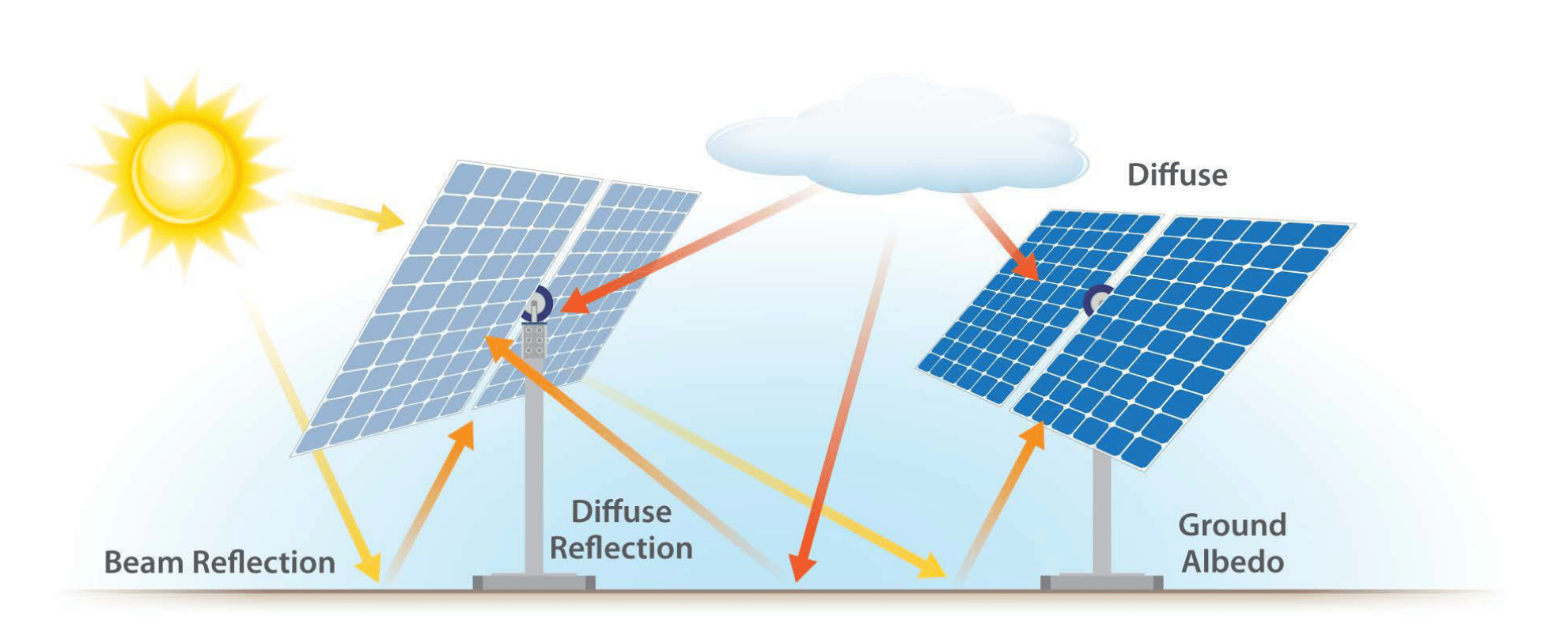
Quantum Dots
Quantum dots are a developing solar technology that have shown promise in laboratory settings. While traditional solar panels only harness visible light, quantum dots harness infrared rays, which make up half of the sun’s power that hits the earth’s surface.
Quantum dots could help improve solar panel efficiency, as they would capture a wider spectrum of sunlight than solar panels currently on the market.
The National Renewable Energy Laboratory (NREL) has shown that, in a lab environment, quantum dots have the ability to achieve a maximum theoretical conversion efficiency of 66%, more than twice the conversion efficiency achievable with current solar technologies.8
Although this technology is still in the research and development phase, it’s promising for the future of solar panels.
Passivated Emitter and Rear Contact (PERC) Solar Cells
Passivated Emitter and Rear Contact (PERC) solar cells are a new technology that modifies traditional solar panels by adding additional reflective layers on the back of the cell. This rear layer reflects sunlight from the back of the solar panel, converting more solar energy and thereby improving the panel efficiency.
Many top solar manufacturers, such as SunPower and REC, use PERC solar cells in their panels. SunPower states that its P-Series solar panels, with PERC technology, can generate 35% more energy over 25 years compared to conventional solar panels of the same size.9
Concentrator Photovoltaic Technology
Concentrating photovoltaics increase the efficiency of solar panel systems by concentrating light onto the solar cells using lenses or mirrors. Essentially, this optical equipment collects light from a larger area and concentrates it onto the small solar cell.10
Concentrating photovoltaics have recorded a 40% efficiency in lab settings, twice the efficiency of traditional solar panels.11 Unfortunately, this technology has not been able to achieve prominence in the market due to barriers of cost and achieving scale in a competitive market.12
Perovskite Cells
Perovskite, a semi-conductive material similar to silicon, is a potential alternative to silicon-based solar cells. The use of perovskite can help to avoid the expensive, energy-intensive process currently used to manufacture traditional cells. This technology is promising because scientists can easily manipulate perovskite cells to have the unique optical, physical and electrical properties that they want.
Scientists have rapidly made advances in the efficiency of perovskite cells in laboratory conditions, and they are working to make perovskite cells more durable and scalable.6 They currently are not stable enough for commercial use.
Dye-Sensitized Solar Cells (DSSC)
Dye-sensitized solar cells (DSSCs) are a type of thin-film solar cell. They are made up of five layers with a sensitizing dye that facilitates the movement of electrons that generate energy when exposed to sunlight.7
DSSCs have the potential to be cheaper, thinner and more flexible than the solar panels currently available. They can also operate in low-light conditions, so they could maintain high efficiency on cloudy days or when exposed to indirect sunlight.
However, DSSCs still have a number of obstacles to overcome before they can be commercially available:
- DSSCs can freeze at low temperatures and expand at high temperatures, making them less resilient in extreme weather conditions.
- The electrolyte solution in DSSCs has volatile organic compounds (VOCs) that are toxic to the environment and humans.13
- Scientists have yet to find a way to avoid using platinum and ruthenium, two expensive metals that make it difficult for DSSCs to be affordable.14
What Should You Consider When Choosing a Solar Panel Type?
The vast majority of solar panels on the market today are monocrystalline solar panels. However, polycrystalline and thin-film solar panels could be a suitable alternative for you.
When choosing a solar panel type, in addition to efficiency, consider the durability, light-induced degradation rate, temperature coefficient and brand of each one. Below, we’ve ranked each type of solar panel either okay, better or best in each category:
| Monocrystalline | Polycrystalline | Thin film | |
| Durability | Best: The single piece of silicon that makes up monocrystalline solar cells are very durable in most weather conditions. | Better: Polycrystalline solar panels are comparable to mono solar panels in terms of weather resistance, but they can be more sensitive to heat. | Okay: Thin-film solar panels are built to be thin and flexible, so they are more prone to breaking or cracking in severe weather conditions. |
| Light-Induced Degradation (LID) | Better: LID is more pronounced in monocrystalline solar panels due to the traces of oxygen in the single piece of molten silicon. | Best: LID is slightly less pronounced in polycrystalline solar panels because this type of solar panel is made through a casting process that introduces less oxygen.15 | Okay: Laboratory results have suggested that thin-film solar panels may experience the most LID relative to other solar panel types.16 |
| Temperature Coefficient | Better: Monocrystalline panels perform less efficiently in extremely hot weather than thin-film panels but are still suitable for most climates. | Okay:
Polycrystalline panels perform less efficiently than monocrystalline and thin-film solar panels in very hot conditions. |
Best: The performance of thin film solar panels will only decrease slightly when it’s hot outside. |
Durability
Monocrystalline and polycrystalline solar panels tend to be the most weather-resistant types of solar panels. Thin-film solar panels are more prone to weather damage, especially from hail.
When it comes to solar panel modules, look for fire, hail and hurricane-resistant features and ratings:
- Fire rating: Solar panels are classified as either Class A, Class B or Class C fire resistance. Look for Class A panels, which are the most resilient against fires.
- Hail rating: In accordance with UL 1703 and UL 61703 standards, solar panels undergo rigorous tests that simulate hail impacts. Both mono and polycrystalline panels can endure hail hitting at up to 50 mph.17
- Hurricane rating: The National Renewable Energy Laboratory (NREL) recommends design features for solar panel systems to help protect against hurricanes and storm damage.18
Light-Induced Degradation
Light-induced degradation (LID) occurs when solar panels experience a temporary drop in performance during the first few hours of sun exposure to the panel.
More research needs to be conducted to fully understand the impacts of LID on solar panels, and how much they can affect solar panel efficiency.19
Monocrystalline solar panels tend to experience LID more than polycrystalline solar panels because of the “traces of oxygen which gets combined with the molten silicon during the Czochraliski process used in growing mono silicon crystals.”20
Basically, the unique monocrystalline solar panel manufacturing process allows for more oxygen to enter the silicon than the manufacturing process of polycrystalline solar panels.
Temperature Coefficient
The temperature coefficient of solar panels represents the percent decrease in productivity your solar panels experience for each one-degree Celsius increase in the temperature above 25 degrees Celcius (77 degrees Fahrenheit).
For instance, if your solar panels have a temperature coefficient of -0.3%/℃, your solar panels would become 0.3% less efficient when it’s 26 degrees Celsius outside, 0.6% less efficient when it’s 27 degrees Celsius outside, 0.9% less efficient when it’s 28 degrees Celcius outside, etc.
Monocrystalline and polycrystalline solar panels have a temperature coefficient between -0.3%/℃ and -0.5%/℃ degrees Celsius, while thin-film solar panels only have a temperature coefficient of about -0.2 degrees Celsius.21
That means that thin-film solar panels maintain more of their efficiency in hot weather than crystalline panels.
The good news is that, unless you live in an area that regularly experiences extreme heat, temperature coefficient doesn’t matter that much. Talk with a solar professional if you’re not sure whether or not you need solar panels with a superior temperature coefficient.
The appearance and efficiency rating of solar panels depends on their material composition. While having high efficiency is favorable, this metric is overestimated in some cases. There are high-quality solar panels of all three types, and you can get excellent results with polycrystalline and thin-film panels when space is abundant.
As mentioned above, polycrystalline and monocrystalline solar panels share the same crystalline silicon wafers. However, the microscopic structure of those crystals is different in each type of panel:
- Monocrystalline solar cells are made from solar PV cells that are cut from a single crystal of pure silicon (hence the prefix “mono”). This is an advanced manufacturing process, which is a key reason why mono solar panels have higher prices.
- Polycrystalline solar cells are made from multiple crystalline silicon fragments that are melted together during the manufacturing process, and they are also called multicrystalline for this reason. Their manufacturing process is simpler, since there is no need to carefully grow a single crystal of silicon. This leads to a lower cost, but also a lower efficiency.
- Thin-film solar panels don’t use silicon crystal cells. Instead, they use thin layers of photovoltaic material. The most common chemical compositions are copper indium gallium selenide (CIGS), cadmium telluride (CdTe) and amorphous silicon (a-Si).
Which Type of Solar Panel is Best For You?
Generally speaking, monocrystalline solar panels are best for residential purposes. However, each type of solar panel has its own advantages and disadvantages. Your budget, roof size and energy needs will determine if monocrystalline, polycrystalline or thin-film solar panels are best for you. Here are the top considerations for each panel type:
- Monocrystalline panels: Monocrystalline panels are great for homeowners with limited roof space or who prefer black-colored solar panels. Monocrystalline panels are the most expensive type of solar panels, but they’re also the most efficient. That means you’d need fewer monocrystalline panels than polycrystalline or thin-film panels to generate the same amount of energy.
- Polycrystalline panels: Polycrystalline panels have a blue hue, and are less efficient than monocrystalline panels. However, they are polycrystalline solar panels cost less than monocrystalline panels.
- Thin-film panels: Thin-film panels are lightweight and thinner than the other two types of solar panels, making them ideal for RVs or camping when a portable solar panel is necessary. They also come in flexible and adhesive varieties that make them more versatile than mono or poly panels. Thin-film panels are not typically recommended for residential roofs due to their low efficiency, but work well on surfaces that are not suitable for the other two types.
So, which type of solar panel is best for your home? To find out for sure, you’ll need to talk to a solar installer near you. Most of the best solar companies and installers offer free consultations that can tell homeowners what type they should buy and how much they will cost.
To get started, you can click below and get connected to a pre-screened solar installer in your area.
FAQ
The three main types of solar panels or monocrystalline, polycrystalline and thin-film solar panels.
Monocrystalline solar panels are the most popular type of solar panels on the market because they are the most efficient and durable panels on the market. However, polycrystalline and thin-film solar panels are cheaper and can be more suitable for large-scale, commercial installations where space is not a constraint.
Monocrystalline solar panels are the most durable type of solar panels.
Thin-film solar panels are the newest type of solar panels. They are designed to be lightweight and thin, but they are not as durable or long-lasting as monocrystalline or polycrystalline solar panels.
Comparing authorized solar partners
-
- Most efficient panels on the market
- National coverage
- Cradle to Cradle sustainability certification
- Great warranty coverage
- Expensive
- Customer service varies by local dealer
A+Best National Provider1985SunPower Panels25-year all-inclusive warranty
Having trouble deciding? Click below and use our process to receive multiple quotes instead:

 233k
233k  41k
41k  Subscribe
Subscribe 
